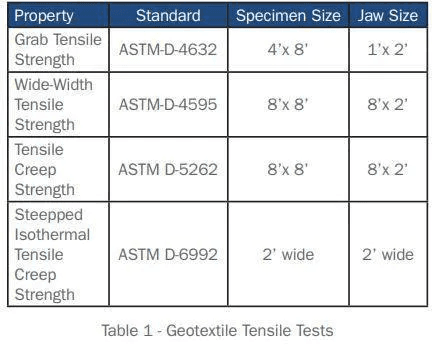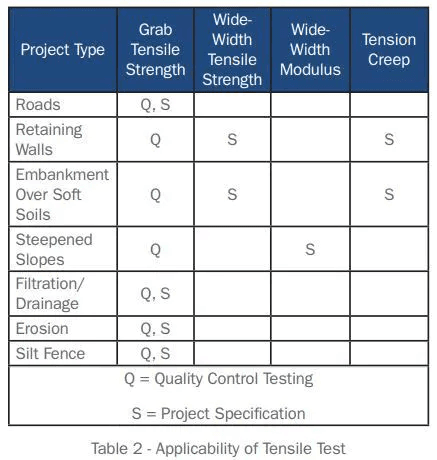What are the key considerations in designing reinforced soil slopes?
A technical overview of reinforced soil slopes (RSS) in geotechnical engineering, focusing on design, erosion control, and innovative materials for slope stability.

What are the key considerations in designing reinforced soil slopes?
A technical overview of reinforced soil slopes (RSS) in geotechnical engineering, focusing on design, erosion control, and innovative materials for slope stability.
How to combine engineered earth armoring with greywater treatment
Resilient water management by combining greywater recycling with engineered earth armoring for irrigation, erosion control, and increased property value.
How can geosynthetics help energy transition?
Geosynthetics accelerate agricultural outputs and improve resilience by optimizing water management through enhanced irrigation efficiency and providing structural stability to agricultural infrastructures like dams and reservoirs.
There are three accepted test methods that indicate the tensile strength of geotextiles. These are the grab tensile test, the wide-width tensile test, and tension creep tests. The American Society for Testing and Materials (ASTM) designation and specimen size for each test are provided in Table 1. The three geotextile tensile test procedures vary in the time required to perform each test, how well the tests measure true tensile strength and the form of the test results. These three test methods were specifically established by ASTM Committee D 35 on Geosynthetics for use on geotextiles. Other ASTM Textile test methods should not be used.

ASTM D-4632, “Standard Test Method for Grab Breaking Load and Elongation of Geotextiles” is the basic tensile test used within the geotextile industry. It provides an index of the ultimate strength of the specimen at failure. As an index it provides an accepted guide to the strength of products but cannot be directly used in design. For example, nonwoven geotextiles exhibit significantly more strength when confined in the end use applications. In the test, each specimen is clamped by one inch jaws in the center of the width and pulled quickly. The test results are expressed in units of total load (such as pounds) rather than in terms of load per unit width. The test is easy to perform, inexpensive, and quick, taking only minutes to complete. As such, it is an excellent index strength test for verifying the quality and consistency of products in accordance with manufacturer’s specifications, as during construction quality control.
ASTM D-4595, “Standard Test Method for Tensile Properties of Geotextiles by the Wide-Width Strip Method” takes longer to complete and is a much more expensive test. In the wide[1]width tensile test each specimen is gripped across their full width and pulled slowly. Unlike the grab tensile test, the wide-width strength results are expressed as a load per unit width. For example, woven MIRAFI® 600X has a wide-width tensile strength of 160 pounds per inch while the grab tensile strength is reported simply as 315 pounds. The wide-width tensile test is rarely used for quality control applications because of the time and expense involved in testing. However, the wide-width test provides a better measure of true tensile strength in woven geotextiles. The test data can be presented in a stress-strain curve, from which the modulus values can be calculated. The wide-width ultimate strength and modulus values can be used for design with woven geotextiles. Because the specimen being tested is not confined, as it would be in its end use, this test does not result in a true design value for nonwoven geotextiles.
ASTM D-5262, “Standard Test Method for Evaluating the Unconfined Tension Creep and Creep Rupture Behavior of Geosynthetics” and ASTM D-6992, “Standard Test Method for Accelerated Tensile Creep and Creep-Rupture of Geosynthetic Materials Based on Time-Temperature Superposition Using the Stepped Isothermal Method” are performed by sustaining a load on a test specimen for up to 10,000 hours (417 days). The specimens are gripped across their full width. The creep deformation or elongation (strain) of the sample is monitored over the test period. From these results, the time to rupture at various load levels or the load level that will cause rupture at a given time can also be determined.

The applicability of the various tensile test methods is summarized in Table 2. The grab tensile test is appropriately specified in applications where the end-use tensile force requirements cannot be quantified and the approach to selecting required geotextile tensile strength is, therefore, largely empirical. This category includes roadway, filtration/ drainage, permanent erosion control, and silt fence applications. The grab tensile test is also an excellent construction quality control method for all applications. In applications where the geotextile will be in continuous long-term stress, tension creep is critical. In these cases, the wide-width ultimate strength should be specified in conjunction with the creep limit. As shown in Table 2, this would include retaining walls and steepened slopes. In embankments constructed over soft soils, the geotextile tensile stress may decrease over time as the subgrade soils consolidate. Tension creep in this case is not an applicable design parameter. For this application, the wide[1]width modulus should be specified at a particular strain. In the design, the geotextile strain is limited to be compatible with the strain developed within the soil mass. This value is typically 5 percentage strain.
References
1. ASTM, 2013, “ASTM D-4632, Standard Test Method for Grab Breaking Load and Elongation of Geotextiles,” American Society for Testing and Materials, West Conshohocken, PA.
2. ASTM, 2011, “ASTM D-4595, Standard Test Method for Tensile Properties of Geotextiles by the Wide[1]Width Strip Method,” American Society for Testing and Materials, West Conshohocken, PA.
3. ASTM, 2011, “ASTM D-4595, Standard Test Method for Tensile Properties of Geotextiles by the Wide[1]Width Strip Method,” American Society for Testing and Materials, West Conshohocken, PA.
4. ASTM, 2009, “ASTM D-6992, Standard Test Method for Accelerated Tensile Creep and Creep-Rupture of Geosynthetic Materials Based on Time-Temperature Superposition Using the Stepped Isothermal Method,” American Society for Testing and Materials, West Conshohocken, PA.